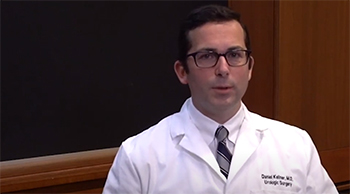Benign Prostatic Hyperplasia (BPH)
What is benign prostatic hyperplasia?
Benign prostatic hyperplasia is a non-cancerous enlargement of the prostate. Because the prostate is enlarged, it squeezes and sometimes blocks the urethra, the tube that carries urine out of the body. That restriction can cause trouble urinating such as slow/weak flow, frequent urination (especially waking up at night to urinate), dribbling/leakage and the feeling that the bladder is not completely empty. These symptoms can affect quality of life and can potentially lead to more serious conditions such as urinary retention, infection, bladder stones and damage to the bladder or kidneys.
What the risk factors?
- Age: An enlarged prostate mainly affects men over 50. Nearly 50 percent of men 51 to 60 have the condition. As many as 90 percent of men over the age of 80 have it. It’s very rare for men under the age of 40 to have an enlarged prostate. While an enlarged prostate can be uncomfortable, it's not life threatening.
- Family history: Men who have a family history of the condition are more likely to suffer from it.
- Other health issues: Men who suffer from obesity, heart disease, or Type 2 diabetes have higher rates of an enlarged prostate diagnoses.
How is it diagnosed?
- The first step is a physical exam which often involves a urine analysis and a digital rectal exam (DRE) in which the physician inserts a finger into the rectum to assess the size and contour of the prostate. The DRE also helps the physician determine if there are any nodules, which may suggest the presence of prostate cancer.
- The exam helps the physician evaluate tenderness which can happen if the prostate is inflamed. Tests may be done in the office to gauge strength of urine flow or check for residual urine in the bladder.
- Next, doctors may run tests to make an accurate diagnosis. These might include a PSA (prostate specific antigen) blood test, urodynamic tests to determine bladder performance, cystoscopy (inserting a scope into the bladder) and transrectal ultrasound which sends sound waves through the wall of the rectum to get an image of the prostate.
What are the treatments for enlarged prostate?
Lifestyle changes
Reducing liquid intake, bladder training (urinating on schedule), abstaining from alcohol and caffeinated beverages, monitoring over-the-counter medications and pelvic floor muscle exercises.
Medication
Based on exam results, physicians may recommend medications called Alpha Blockers that relax muscle fibers in the prostate and bladder for increased urine flow and decrease frequency of urination. A second class of medication called Alpha Reductase Inhibitors works to block the hormones that cause the prostate to swell. Some patients may take a combination of both types of medication.
Minimally-invasive procedures
If medications aren’t effective, a physician might recommend one of several outpatient procedures including:
- MRI-guided prostate ablation: This procedure, known as Transurethral Ultrasound Ablation (TULSA) aims to remove diseased prostate tissue while protecting the surrounding organs using real-time magnetic resonance imaging (MRI). During this outpatient procedure, ultrasound waves are precisely delivered through the urethra directly to the affected tissue in the prostate. Rectal and urethral cooling throughout the treatment help to protect these areas from any unintended heat.
- UroLift: Performed in the doctor’s office, this procedure involves inserting tiny implants that lift the enlarged prostate out of the way to solve the problem of a blocked urethra. It takes only about an hour and no prostate tissue is removed.
- GreenLight laser treatment: In this procedure, laser energy is used to vaporize prostate tissue to create a channel in the urethra for easier urination. An efficient treatment, with minimal side effects, patients go home the same day and can resume normal activities within 1-2 days.
- Prostatic arterial embolization (beads): Performed by an interventional radiologist using mild sedation, this procedure involves releasing tiny beads into the arteries that supply the prostate gland, accessed through a small hole in the wrist or groin. The beads (which can't be felt by the patient) travel to the patient's prostatic arteries and block off blood flow to the swollen prostate. Over time, the prostate gland shrinks. The two-hour outpatient procedure often results in improvement of symptoms such as weak stream, frequent urination and incomplete emptying within just a few weeks. Learn more about interventional radiology
Surgery
For patients who don’t get relief from medication or a less invasive procedure, surgical options include:
- Transurethral resection of the prostate (TURP) — this involves surgical removal of excess tissue from the prostate to enable flow.
- Transurethral incision of the prostate (TUIP) is a procedure in which the physician cuts small grooves in the area where the prostate and bladder are connected to open the urinary channel so that urine can pass more easily.
- HoLEP (Holmium laser enucleation of the prostate) is a type of laser surgery used to remove tissue that is blocking flow.
Patients will decide with their doctor if aggressive treatment is warranted, depending on the size of the prostate and severity of symptoms.


